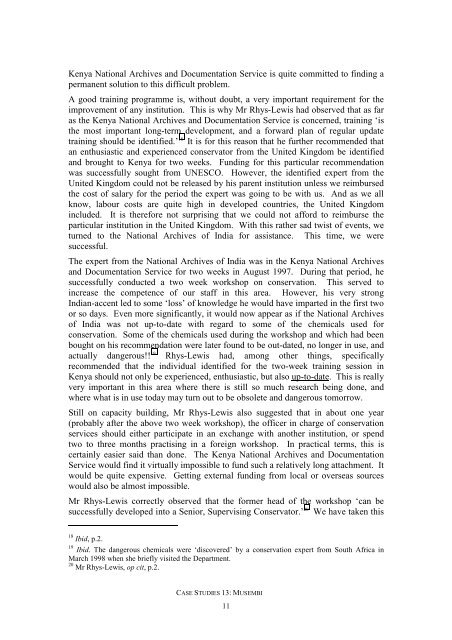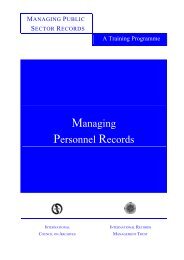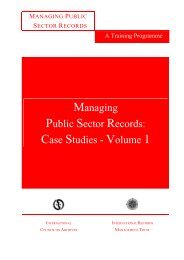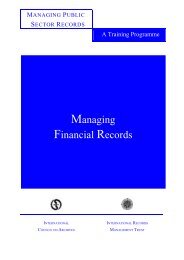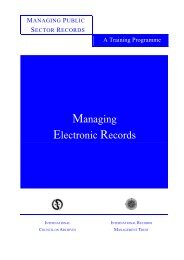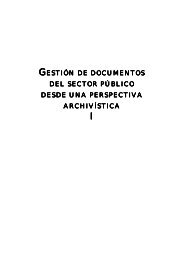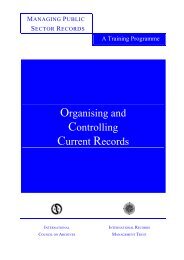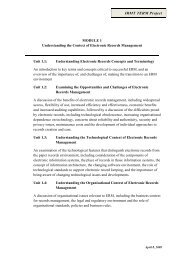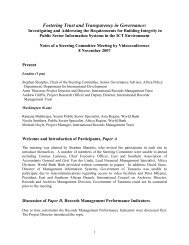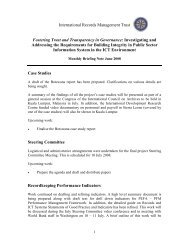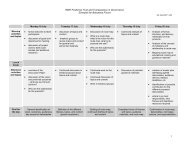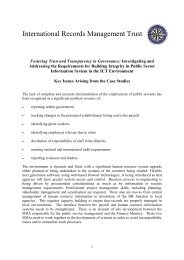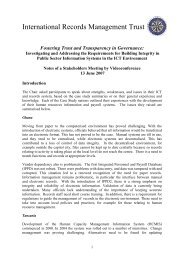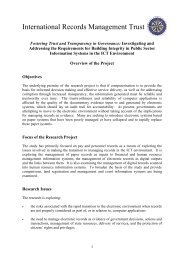managing public sector records: a study programme - International ...
managing public sector records: a study programme - International ...
managing public sector records: a study programme - International ...
You also want an ePaper? Increase the reach of your titles
YUMPU automatically turns print PDFs into web optimized ePapers that Google loves.
Kenya National Archives and Documentation Service is quite committed to finding a<br />
permanent solution to this difficult problem.<br />
A good training <strong>programme</strong> is, without doubt, a very important requirement for the<br />
improvement of any institution. This is why Mr Rhys-Lewis had observed that as far<br />
as the Kenya National Archives and Documentation Service is concerned, training ‘is<br />
the most important long-term development, and a forward plan of regular update<br />
training should be identified.’ 18 It is for this reason that he further recommended that<br />
an enthusiastic and experienced conservator from the United Kingdom be identified<br />
and brought to Kenya for two weeks. Funding for this particular recommendation<br />
was successfully sought from UNESCO. However, the identified expert from the<br />
United Kingdom could not be released by his parent institution unless we reimbursed<br />
the cost of salary for the period the expert was going to be with us. And as we all<br />
know, labour costs are quite high in developed countries, the United Kingdom<br />
included. It is therefore not surprising that we could not afford to reimburse the<br />
particular institution in the United Kingdom. With this rather sad twist of events, we<br />
turned to the National Archives of India for assistance. This time, we were<br />
successful.<br />
The expert from the National Archives of India was in the Kenya National Archives<br />
and Documentation Service for two weeks in August 1997. During that period, he<br />
successfully conducted a two week workshop on conservation. This served to<br />
increase the competence of our staff in this area. However, his very strong<br />
Indian-accent led to some ‘loss’ of knowledge he would have imparted in the first two<br />
or so days. Even more significantly, it would now appear as if the National Archives<br />
of India was not up-to-date with regard to some of the chemicals used for<br />
conservation. Some of the chemicals used during the workshop and which had been<br />
bought on his recommendation were later found to be out-dated, no longer in use, and<br />
actually dangerous!! 19 Rhys-Lewis had, among other things, specifically<br />
recommended that the individual identified for the two-week training session in<br />
Kenya should not only be experienced, enthusiastic, but also up-to-date. This is really<br />
very important in this area where there is still so much research being done, and<br />
where what is in use today may turn out to be obsolete and dangerous tomorrow.<br />
Still on capacity building, Mr Rhys-Lewis also suggested that in about one year<br />
(probably after the above two week workshop), the officer in charge of conservation<br />
services should either participate in an exchange with another institution, or spend<br />
two to three months practising in a foreign workshop. In practical terms, this is<br />
certainly easier said than done. The Kenya National Archives and Documentation<br />
Service would find it virtually impossible to fund such a relatively long attachment. It<br />
would be quite expensive. Getting external funding from local or overseas sources<br />
would also be almost impossible.<br />
Mr Rhys-Lewis correctly observed that the former head of the workshop ‘can be<br />
successfully developed into a Senior, Supervising Conservator.’ 20 We have taken this<br />
18 Ibid, p.2.<br />
19 Ibid. The dangerous chemicals were ‘discovered’ by a conservation expert from South Africa in<br />
March 1998 when she briefly visited the Department.<br />
20 Mr Rhys-Lewis, op cit, p.2.<br />
CASE STUDIES 13: MUSEMBI<br />
11


